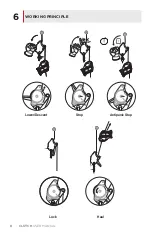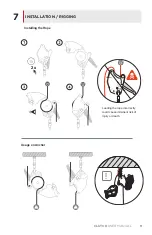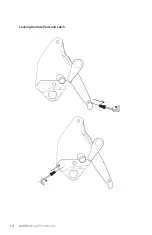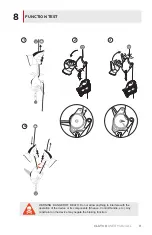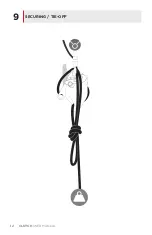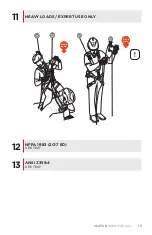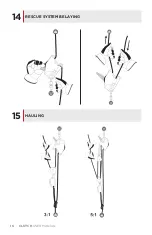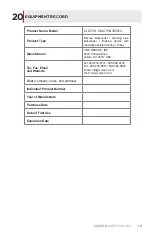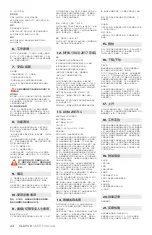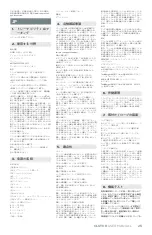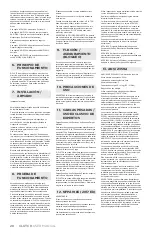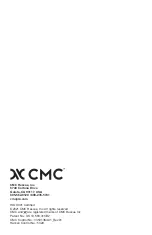
CLUTCH
USER MANUAL
21
EN
1. TRACEABILITY &
MARKINGS
See section 1.
2. FIELD OF
APPLICATION
These instructions explain the correct use of your
equipment. Only certain techniques and uses are
described. The warning symbols inform you of
some potential dangers related to the use of your
equipment, but it is impossible to describe them
all. Check cmcpro.com for updates and additional
information. You are responsible for heeding each
warning and using your equipment correctly. Any
misuse of this equipment will create additional
dangers. Contact CMC if you have any questions or
difficultyunderstandingtheseinstructions.
Standards
Descent Control Device, Belay Device, Pulley per
NFPA 1983 (2017 ED)
Descent Control Device per ANSI/ASSE Z359.4
- 2013
Responsibility
Before using this device, you must:
• Read and understand these user instructions
and warnings.
•
Getspecifictraininginitsproperuse.
• Familiarize yourself with its capabilities and
limitations.
• Understand and accept the risks involved.
• Have a rescue plan in place to deal with any
emergencies that could arise during use of
the device.
•
Bemedicallyfitforactivitiesatheight.Becapable
to control your own security and any possible
emergency situations.
Specifictrainingintheactivitiesdefinedinthefield
of application is essential before use. This device
must only be used by competent and responsible
persons, or those placed under the direct and visual
control of a competent and responsible person.
Gaining an adequate expertise in appropriate
techniques and methods of protection is your own
responsibility. You personally assume all risks and
responsibilities for all damage, injury or death,
which may occur during or following incorrect use
of this device in any manner whatsoever. If you
are not able, or not in a position to assume this
responsibility or to take this risk, do not use this
equipment.
This device must not be loaded beyond its strength
rating, nor be used for any purpose other than that
for which it is designed.
This equipment does not need to be a personal
issue item.
WARNING: Activities involving the use
of this device are inherently dangerous.
You are responsible for your own actions,
decisions and safety.
WARNING: Inert suspension in a harness
can result in serious injury or death.
3. NOMENCLATURE
1. Moving Side Plate
2. Side Plate Release Latch
3. Tension Rope Guide
4. Sheave
5. Sheave Swing Arm
6. Friction Shoe
7. Becket
8. Control Handle
9. Chassis
10. Attachment Eye
11. Side Plate Lockout Screw Hole
12. Side Plate Lockout Screw
13. Handle Positions
A. Stop
B. Standby
C. Release (Range)
D. Antipanic
14. Rope Path
A. Tension Side (Load/Anchor)
B. Braking Side
C. Brake Hand
4. INSPECTION
POINTS TO VERIFY
Inspection Points to Verify
The CLUTCH is controlled through CMC’s ISO
9001 approved quality processes, however it should
be thoroughly inspected before being placed in
service. The CLUTCH is also a robust product but
should still be inspected after each use to ensure
that damage did not occur. The CLUTCH does not
have a known time-limit to the usable life, however
CMC recommends a detailed inspection by a
competent person at least once every 12 months
(depending on current regulations in your country,
and your conditions of use). Record the date of the
inspection and the results in the equipment log or
on inspection forms that can be found on cmcpro.
com/ppe-inspection/.
Before Each Use
• Perform a function test of the device by loading
it properly on the rope and ensuring that it
holds a test load without slipping on the rope as
described in Section 8 of this Manual.
• Verify the presence and legibility of the product
markings.
• Verify that the device has no cracks, deformation,
excessive wear, corrosion, etc.
• Check for the presence of dirt or foreign objects
thatcanaffectorpreventnormaloperation(e.g.
grit, sand, pebbles, etc.).
• Move the Control Handle through its range
of motion.
• Move the Control Handle to the Standby
position and check that the Sheave Swing Arm
moves freely.
• Check that the Sheave is in good condition and
freely rotates only anti-clockwise.
• Check the Sheave for wear; when the wear indi-
cators are no longer visible, the holding capacity
of the device may be compromised. Refer to the
following page for details on the wear indicators.
Take extra precaution and consider retirement
of the device.
• Check the Side Plate for deformation or
excessive play; if the Side Plate can pass over
the Chassis (see diagram), discontinue use of
the CLUTCH.
During Each Use
Make sure that all pieces of equipment in the
system are correctly positioned with respect to each
other. Regularly monitor the condition of the device
and its connections to other equipment in the
system. Do not allow anything to interfere with the
operation of the device or its components (Sheave,
Control Handle, etc.). Keep foreign objects out of
the device. To reduce the risk of a free fall keep
all slack out of the rope between the device and
the load/anchor.
WARNING: performance can vary depend
-
ing on the state of the rope (wear, mud,
moisture, ice, etc).
Retirement
This equipment has an unlimited lifetime, how-
ever usage and exceptional events may require
retirement. Destroy retired equipment to prevent
further use.
A device must be retired when:
• It has been subjected to a major fall (or load).
• It fails to pass inspection.
• It fails to hold a load without slipping on the rope.
• You have any doubt as to its condition or
reliability.
• You do not know its full usage history.
• When it becomes obsolete due to changes in leg-
islation, standards, technique or incompatibility
with other equipment, etc.
WARNING: An exceptional event can lead
you to retire a device after only one use,
depending on the type and intensity of
usage and the environment of usage (harsh
environments, marine environment, sharp
edges, extreme temperatures, chemical
products, etc.)
Carrying, Maintenance, Storage &
Transport
Clean and dry this equipment after each use to
remove any dust, debris and moisture. Use clean
watertowashoffanydirtordebris.Donotusea
pressure washer to clean the device. If device gets
wet, allow the device to air dry at temperatures
between 10° C (50° F) and 30° C (86° F), keep
away from direct heat. During use, carrying, storage
and transport, keep the equipment away from acids,
alkalis, rust and strong chemicals. Do not expose
theequipmenttoflameorhightemperatures.Store
in a cool, dry location. Do not store where the
equipment may be exposed to moist air, particularly
where dissimilar metals are stored together. Ensure
that the equipment is protected from external impact
and keep out of direct sunlight.
Repairs
All repair work shall be performed by the manu-
facturer.Allotherworkormodificationsvoidthe
warranty and releases CMC from all liability and
responsibility as the manufacturer.
5. COMPATIBILITY
Verification
Verify that this device is compatible with the other
elements of the system in your application (compat-
ible = good functional interaction).
WARNING: Danger may arise and function
-
ality may be compromised by combining
other items of equipment in conjunction
with the CLUTCH during use. The user as
-
sumes all responsibility for any non-stan
-
dard use of the device or the components
being used with the device.
NFPA 1983 (2017 ED) “GENERAL USE”
Descent Control Device / Belay Device
/ Pulley
• CMC™ Static-Pro LifeLine 12.5 mm P/N 28120X
General Use Life Safety Rope
• Teufelberger KM III 13 mm P/N K0X160 General
Use Life Safety Rope
ANSI/ASSE Z359.4-2013 Descent Control
Device
• Teufelberger KM III 13 mm P/N K0X160 60-
141kg MAX 200m
Ropes
Use only the recommended diameters and types of
synthetic rope. The use of any other diameter/type
of rope changes the performance of the device,
especiallythebrakingeffectiveness.
WARNING: The stated diameter of ropes on
the market may have a tolerance of up to
+/- 0.2 mm. Certain ropes may be slippery:
new ropes, small diameter ropes, wet or
frozen ropes. Braking effectiveness and
ease of giving slack can vary depending on
the diameter, construction, wear and tear,
and surface treatment of the rope, as well
as other variables such as frozen, muddy,
wet, dirty ropes, etc. At each use, the user
must familiarize him or herself with the
braking effect of the device on the rope and
22
MANUAL TEXT
Summary of Contents for CMC CLUTCH
Page 4: ...CLUTCH USER MANUAL 4 1 TRACEABILITY MARKINGS H K A C B F G D E L I J...
Page 6: ...CLUTCH USER MANUAL 6 3 NOMENCLATURE 11 2 6 13 14...
Page 8: ...CLUTCH USER MANUAL 8 6 WORKING PRINCIPLE Lower Descent Stop Antipanic Stop Lock Haul...
Page 10: ...CLUTCH USER MANUAL 10 Locking the Side Plate and Latch...
Page 12: ...CLUTCH USER MANUAL 12 9 SECURING TIE OFF X m s max...
Page 13: ...CLUTCH USER MANUAL 13 10 PRECAUTIONS FOR USE X m m X m...
Page 14: ...CLUTCH USER MANUAL 14 X m s max X m s max X m s max...
Page 16: ...CLUTCH USER MANUAL 16 14 RESCUE SYSTEM BELAYING 15 HAULING...
Page 17: ...CLUTCH USER MANUAL 17 16 DESCENT AND LOWERING 17 ASCENDING...
Page 30: ...CLUTCH USER MANUAL 30...
Page 31: ...CLUTCH USER MANUAL 31...


